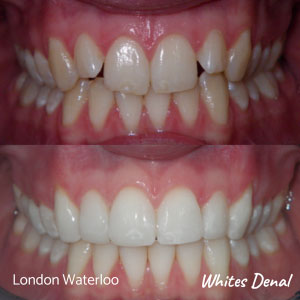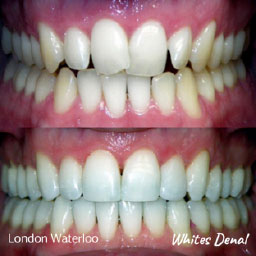What is the minimum time to wear braces?
Call us on 0208 616 0590 or email us at [email protected] to book an appointment.
Have Always Wanted
as little as £4/day.

What Braces treatment (teeth aligners) is right for you
Orthodontic braces are a great and increasing popular way with adults in London to straighten and shift their teeth, improve how they look and how they work. Fixed braces can also benefit you with the long-term health of your teeth and gums as well as making eating easier, by spreading the biting pressure across all your teeth. Our orthodontic dental team at Whites Dental in London Waterloo can help you decide whether orthodontic braces are the right teeth aligners option for you.
When you meet your orthodontist for the first time, he or she will always give you an estimated time of duration for your treatment. They will explain the procedure step by step, and will prepare you for when the time arrives to get your braces off. Usually, most patients will start to notice major changes in the appearance of their teeth within the first six months of treatment. The length of time you will be required to wear braces will depend on how much work there is to do, and how much your teeth need to be moved. It will also be affected by how well you follow your dentist’s instructions and your own biological response to the brace.
Generally speaking, a traditional fixed brace will be used for anywhere between six months and two years. Removable braces can take less time but are often worn before and after treatment with a fixed brace. There are also options such as Fastbraces, the fastest method to straighten teeth, for those who do not require a gradual progression. Most people are advised to wear a retainer full-time for up to three months after their fixed brace has been removed, gradually reducing its use to one or two nights a week. This prevents the teeth from moving back out of line. However, the only way to really guarantee teeth to stay straight after any form of braces is to continue to use a retainer at least once a week for as long as possible. This is called ‘long-term retention’. An alternative option is to bond the teeth in their new position.
While any orthodontic treatment requires commitment, the rewards are well worth it and last a lifetime. Healthy, straight teeth with proper jaw alignment and a beautiful smile can improve confidence and wellbeing – priceless outcomes and perfectly achievable with the right treatment.
Who needs to have their teeth straightened
If misaligned teeth are impacting your daily life, you should consider getting treatment. If you have trouble chewing or biting your food, or if your teeth affect the way that you speak, you may be a candidate for jaw surgery or braces.
If you don’t like the way your teeth look because they’re crooked or rotated, orthodontic treatment can straighten out your smile.
The ideal time to get braces is between the ages of 9 to 14 years old. But you’re never too old to get braces, and more adults are opting to get orthodontic treatment later in life.
Here are some signs that you may be a candidate for braces:
- crowded or misaligned teeth
- jaws that move or click
- difficulty chewing or biting down
- jaws that don’t close properly or create a seal when the mouth is at rest
- difficulty pronouncing certain words or making certain sounds
- mouth breathing
While it is impossible to forecast exactly when you will be able to get your braces off, there are a few aspects that can help you have them removed earlier:
- Your age- the treatment can be faster with younger people.
- Following your orthodontics’ instruction- such as maintaining good dental hygiene is vital to any treatment to ensure its success.

- The teeth might look straightened, but the bite might not yet be. This is one of the most important factors which will determine whether or not you will have to continue to wear the braces.
- Depending on the complexity of the case including the orthodontic issue being fixed, the problems identified at the beginning of treatment, can contribute to a stretched-out treatment. Your treatment may go on for longer than predicted, if the problems are not easily corrected and more severe than initially noted. Such orthodontic treatments will naturally take longer than with a patient who requires less severe adjustments.
- If the teeth are not straight enough for the patient and not aligned enough for the orthodontist, a few extra months may be needed before your braces can be removed.

It is quite hard to generally say how long an orthodontic treatment can take as it depends on the severity of the malocclusion or dental problems that the patient suffers from. Generally, orthodontic treatment through braces can take anything from 6 months to 30 months.
It is essential to remember that you should only get your braces off when you and your orthodontist are completely satisfied with the position of your teeth, as getting them off too early may leave you with unwanted results.
If you are considering braces and would like to know how long you can expect treatment to last, book a free consultation with one of our team, we will be happy to answer any questions you may have!
For more details in regard to orthodontic braces, you can visit our orthodontics page at https://www.whitesdental.co.uk/orthodontist-teeth-straightening-london-waterloo/
At Whites Dental, we try extremely hard to provide all our patients the best possible orthodontic care we can. To enable that, we work with some of the most experienced orthodontic practitioners in London. Feel free to give us a call to discuss more.


